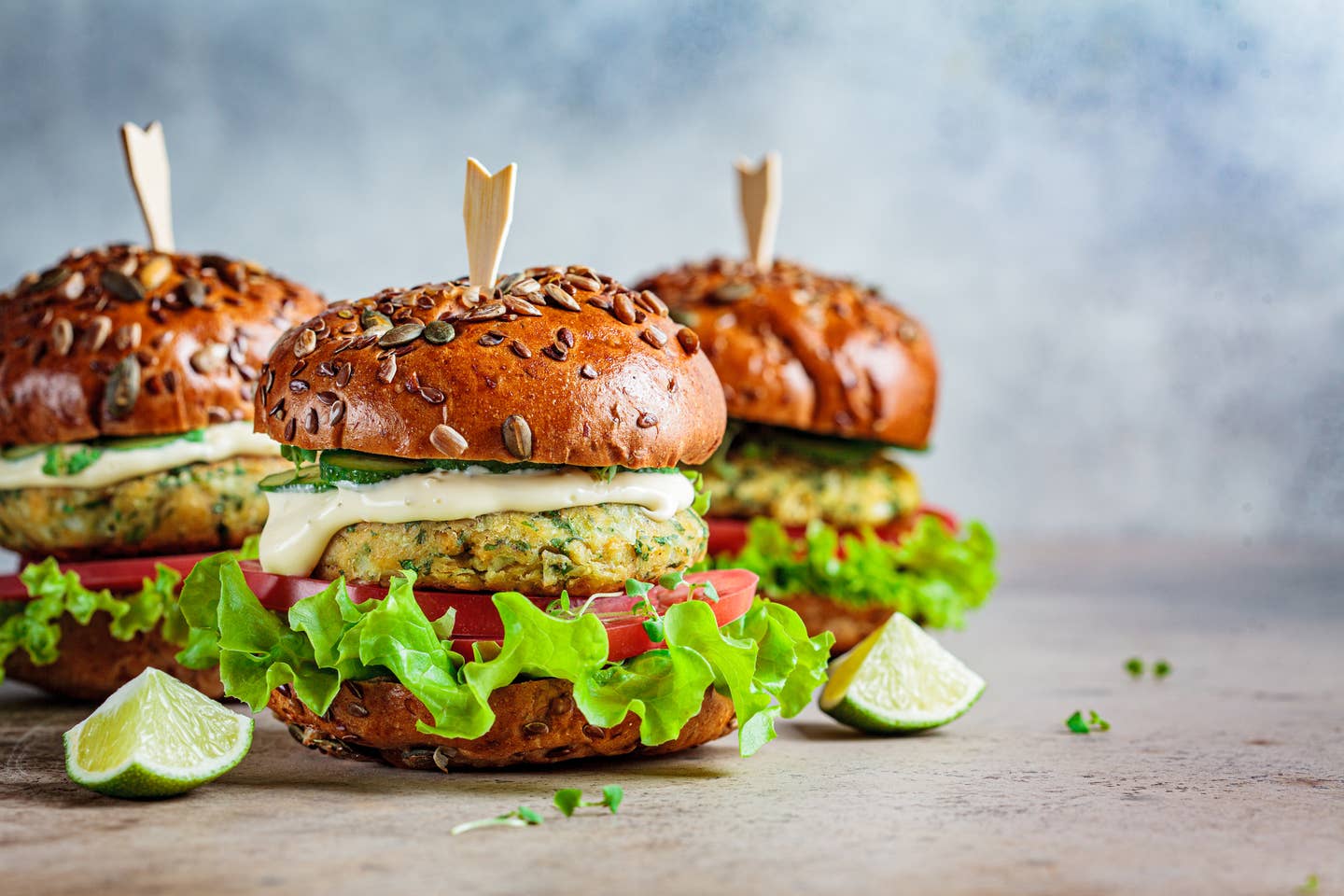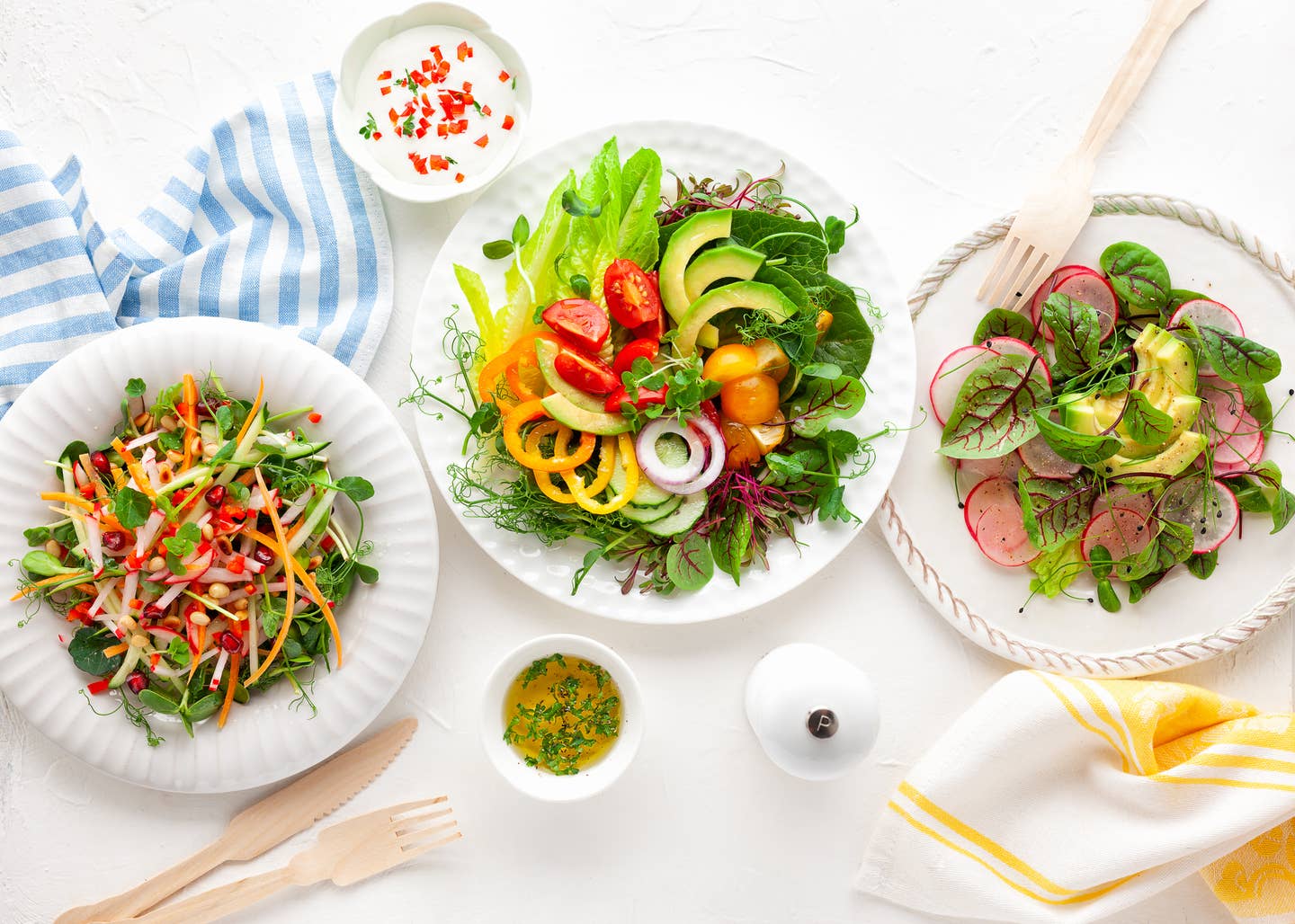
7 Ways to Get Meat Lovers to Eat More Plant-Based, According to Nutritionists
Your grill-master dad recently just saw his cardiologist and tells you he wants to make some dietary changes. Your best friend from college recently reached out saying she’d love some help in embracing a more plant-based lifestyle. Whatever the case, you’re grillin’ (tempeh) and willin’ to help. But what’s the best tactic? According to a study from Faunalytics, a research organization that studies ways to encourage meat-eaters to go plant-based, asking someone to reduce their meat intake is more effective than asking them to go entirely vegan.
Nutritionists who help people get healthier for a living, offer their best advice for how to approach someone or how to coach a loved one who has told you they want to reduce their meat and dairy consumption. Here, the pros share their top tips for helping bring someone along a plant-based journey to help them just add more fruits and vegetables to their plates.
1. Tell them that instead of subtracting animal foods, focus on adding more vegetables
Larger lifestyle shifts can come later, but one of the best ways to start out is by having friends and family members think about what they can add to their plates, instead of what they “have to” take away. “The easiest way to eat more plant foods when it comes to vegetables is to just add more to your current meals. For example, if you're following a recipe, and it calls for one cup of spinach add two-to-three cups or if you're adding roasted vegetables to your plate make sure to add an extra one or two spoonfuls,” suggests Kathleen Oswalt, RDN.
2. Help them set small goals to hold themselves accountable along the way
Look, not everybody is going to go cold turkey into the plant-based world (or even nix eating meat completely). In fact, making a huge change like cutting animal protein out of your diet all at once is less likely to stick, says Melanie Betz MS, RD, CSR, CSG at The Kidney Dietitian. Instead, she advises people to set small, thoughtful goals that feel “right and realistic” to them to achieve the ultimate change they want to make. “For some, this might be Meatless Mondays. For others, it could be eating meat just two days a week.”
3. Make veggies taste like something they’re used to eating
“When veggies are cooked and seasoned in a familiar way, people are surprised at just how tasty they can be,” says Emily Danckers, MS, RD. “Try grilling a half of a romaine lettuce heart, or mash up some parsnips to make a mashed potato-like side dish.” Cauliflower crust pizza?. Bring it on.
4. Have them practice this genius “seconds helpings” rule
“I like to tell clients to go for second helpings of vegetables before second helpings of anything else,” says Talia Hauser, RD, LDN. “This way you know you're getting more vegetables in your diet but also filling up on low-calorie, nutritious foods.” For a side dish that’s sure to have people digging in for more, try this grain millet and cauliflower mash with garlic gravy.
5. Spark their curiosity
Like anything in life, internal motivation is key to making positive, sustainable change. One easy way to get the motivation to come from a loved one and not from, say, your nagging or shoving kale-everything down their throats is to let them get involved proactively with meal planning. “Ask them what they would like to try. Ask them which veggies they like or are interested in,” says Danckers. “Picking out a recipe together makes someone much more interested and involved than when they are forced to try something that they had no hand in choosing.”
6. Utilize “transition foods”
If you live with a loved one who you’re trying to help eat more plant-based, follow the lead of Anna Tseng, MPH, RDN, LDN, and start looking for ways in which you can add more plant-based ingredients into meals a few times a week. “For super carnivorous types, using a bit of ‘transition foods’ such as commercially processed vegan meat alternative products may be helpful in the beginning stages of the transition and these can be phased out later in the transition if desired,” says Tseng. “Start to make small adjustments to existing meals (e.g., using shredded vegan cheese instead of dairy cheese shreds, a vegan mayonnaise, or using soy-based hot dogs), beginning with one new plant-based change at a time and when that is accepted, moving on to the next.”
7. Think beyond dinner
Many often prioritize vegan meals at supper but forget about other opportunities to add in more plants throughout the day. “Breakfast is a great way to up your vegetable count for the day... Add fresh or frozen veggies to scrambled eggs or an omelet, top a breakfast sandwich with spinach and tomato or try a breakfast burrito with scrambled eggs, black beans, peppers, and onions,” says Andrea Stokes, BASc, RD. Remember, the more anyone tips the scale towards eating more plant-based foods — even if it’s sautéed veggies over eggs instead of a totally vegan tofu scramble — it’s a step in the right direction for health, the planet, and animal welfare.
A few more ideas: “You can even add vegetables to homemade baked goods. For example, you can toss in some shredded zucchini or carrot to muffin recipes, or try a scoop of pumpkin purée in your oatmeal or morning smoothie,” adds Stokes. P.S. These vegan oatmeal carrot muffins will blow any kind of eater away — even your grillmaster dad.
Top 10 Sources of Plant-Based Protein According to a Nutritionist
1. Seitan
Protein: 21 grams in ⅓ cup (1 ounce) Seitan isn’t as popular as other proteins, but it should be! Made from wheat gluten, its texture resembles ground meat. It’s often used in pre-made veggie burgers or meatless nuggets. Seitan has a savory taste, like mushrooms or chicken, so it works well in dishes that call for an umami flavor. With a hearty texture, seitan can be the star of practically any vegan main dish. Add it to stir-fries, sandwiches, burritos, burgers, or stews. Like tofu, seitan will take on the flavor of any marinade or sauce.
2. Tempeh
Protein: 16 grams in 3 ounces If you like a protein with a bit of bite, add tempeh to your list. Made from fermented soybeans, tempeh has a slightly nutty flavor and is pressed into a block. Most varieties include some sort of grains, such as barley or millet. Not only is tempeh a plant-based source of protein, but the fermentation process also creates good-for-your-gut probiotics. You can cut tempeh right off the block and use it as the base for a sandwich or pan-fry it with some sauce. Or, crumble, heat, and make it the star of your next taco night.
3. Lentils
Protein: 13 grams in ½ cup cooked Lentils come in multiple varieties--red, yellow, green, brown, black. Regardless of the type lentils are small but mighty nutritional powerhouses. They pack a good amount of protein as well as iron, folate, and fiber. When cooked, brown lentils retain their texture and can be the base for a grain bowl or make a hearty substitute for ground meat in meatballs, lasagna, tacos or Bolognese. Red lentils are a bit softer and make a nice add-in for a hearty soup, chili, or stew.
4. Hemp Seeds
Protein: 10 grams in 3 tablespoons Hemp seeds are a tender and nutty seed, derived from the hemp plant. They contain good amounts of omega-3s, iron, folate, magnesium, phosphorus, and manganese. They are also a solid source of both soluble and insoluble fiber, which helps to keep your digestive tract healthy and humming. Because they pack a double whammy of protein and healthy fats, hemp seeds can help satisfy hunger, preventing those embarrassing stomach growls as you slog your way to your lunch break. Add them to your morning smoothie or sprinkle them on top of yogurt, oatmeal, or even a salad.
5. Tofu
Protein: 9 grams in 3 ounces (⅕ of a block) Made from coagulated soybeans, tofu is the most popular plant-based protein. Soy is one of the only meatless "complete" proteins, meaning that it contains all of the essential amino acids that the body can’t make but needs for muscle and immune function. With 15% of your daily calcium needs, tofu is also a good replacement for dairy.
6. Edamame
Protein: 9 grams of protein in ½ cup This sushi appetizer is a nutrient powerhouse, so eat it anytime. Edamame is really just another name for soybeans in their pods. Let’s list off some stats--a small ½-cup serving of edamame has 9 grams of protein, 15% of your daily vitamin C, 10% of your daily iron and 16% of your daily fiber. Keep a bag of edamame in your freezer to serve as a fun-to-eat side dish or opt for the shelled variety to toss into salads or a grain bowl.
7. Quinoa
Protein: 8 grams per cup (cooked) Quinoa is an ancient grain and since it's gluten-free a great choice for anyone avoiding gluten. Add it to your burger recipe to create filling texture, or instead of meat in your taco or burrito. Quinoa is among the healthiest foods on the planet, delivering phytonutrients that have anti-inflammatory qualities, so keep it in your pantry for any meal that needs a filling grain. Just remember to soak it and rinse before cooking to get rid of any bitter taste.
8. Black Beans
Protein: 7 grams in ½ cup (canned) Eating beans on the regular might as well be a prerequisite for a plant-based diet. Not only are canned black beans inexpensive, but they also contribute 10% of your daily iron and 25% of your daily fiber to your diet. For less than $1 a can, beans can be the star of tacos, quesadillas, salads, soups, burgers, or dips.
9. Amaranth
Protein: 6 grams in ⅔ cup (cooked) Chances are you’ve never cooked amaranth. But you should, since this tiny, gluten- free grain is packed with almost 30% of your daily fiber and 20% of your daily iron. Cook it like a traditional grain to yield a soft, porridge-like texture. Many people add amaranth to other a hot breakfast cereal mixture, like oats and quinoa. It also pops like popcorn. Toss it in a pot with some oil and wait for it to pop up into a nutritious snack.
10. Peas
Protein: 5 grams in ⅔ cup If peas were one of your most hated veggies as a kid, it’s time to give them another chance. These green beans are a great low-calorie protein to keep in your freezer. Sure, they don’t always taste great when steamed or microwaved (who wants to eat mushy, overcooked peas?), but they do blend well into a yummy puree that can be slathered on toast. To amp up the flavor, add some lemon juice or mint to your mix before you blend.
More From The Beet






